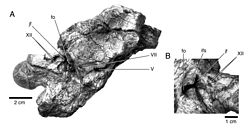
Philip John Currie is a Canadian palaeontologist and museum curator who helped found the Royal Tyrrell Museum of Palaeontology in Drumheller, Alberta and is now a professor at the University of Alberta in Edmonton. In the 1980s, he became the director of the Canada-China Dinosaur Project, the first cooperative palaeontological partnering between China and the West since the Central Asiatic Expeditions in the 1920s, and helped describe some of the first feathered dinosaurs. He is one of the primary editors of the influential Encyclopedia of Dinosaurs, and his areas of expertise include theropods, the origin of birds, and dinosaurian migration patterns and herding behavior. He was one of the models for palaeontologist Alan Grant in the film Jurassic Park.
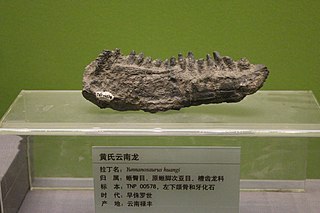
Yunnanosaurus is an extinct genus of sauropodomorph dinosaur that lived approximately 199 to 183 million years ago in what is now the Yunnan Province, in China, for which it was named. Yunnanosaurus was a large sized, moderately-built, ground-dwelling, quadrupedal herbivore, that could also walk bipedally, and ranged in size from 7 meters (23 feet) long and 2 m (6.5 ft) high to 4 m (13 ft) high in the largest species.

Bellusaurus was a small short-necked sauropod dinosaur from the Late Jurassic (Oxfordian) which measured about 4.8 metres (16 ft) long. Its fossils were found in Shishugou Formation rocks in the northeastern Junggar Basin in China.
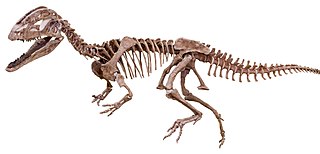
Sinosaurus is an extinct genus of theropod dinosaur which lived during the Early Jurassic Period. It was a bipedal carnivore approximately 5.5 metres (18 ft) in length and 300 kilograms (660 lb) in body mass. Fossils of the animal were found at the Lufeng Formation, in the Yunnan Province of China.
Daanosaurus was a genus of dinosaur. It was a sauropod which lived during the Late Jurassic. It lived in what is now China, and was similar to Bellusaurus.
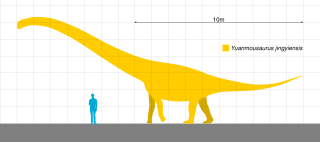
Yuanmousaurus was a sauropod dinosaur from the Middle Jurassic period of China. It is known from incomplete remains, recovered in 2000 from the Zhanghe Formation in Yuanmou County in Yunnan Province. Yuanmousaurus was a relatively large sauropod and may have reached about 17 meters (56 ft) in length. It was a basal member of the Sauropoda, but its exact systematic position is unclear. A recent study placed Yuanmousaurus within the family Mamenchisauridae. It may be a dubious genus. The only and type species was Yuanmousaurus jiangyiensis.

Camarasauridae is a family of sauropod dinosaurs. Among sauropods, camarasaurids are small to medium-sized, with relatively short necks. They are visually identifiable by a short skull with large nares, and broad, spatulate teeth filling a thick jaw. Based on cervical vertebrae and cervical rib biomechanics, camarasaurids most likely moved their necks in a vertical, rather than horizontal, sweeping motion, in contrast to most diplodocids.

In human anatomy, the neurocranium, also known as the braincase, brainpan, or brain-pan, is the upper and back part of the skull, which forms a protective case around the brain. In the human skull, the neurocranium includes the calvaria or skullcap. The remainder of the skull is the facial skeleton.
The Chuanjie Formation, is a geological formation in Yunnan, China. It dates back to the Middle Jurassic. It was formerly referred to as being the lower member of the "Upper Lufeng" as opposed to the underlying "Lower Lufeng" now referred to as the Lufeng Formation. Tracks of theropods and sauropods, as well as thyreophorans are known from the formation.

Daxiatitan is a genus of sauropod dinosaur known from the Lower Cretaceous of Gansu, China. Its type and only species is Daxiatitan binglingi. It is known from a single partial skeleton consisting of most of the neck and back vertebrae, two tail vertebrae, a shoulder blade, and a thigh bone. At the time of its discovery in 2008, Daxiatitan was regarded as potentially the largest known dinosaur from China.
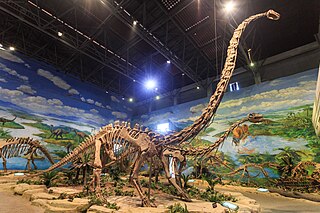
Mamenchisauridae is a family of sauropod dinosaurs belonging to Eusauropoda known from the Jurassic and Early Cretaceous of Asia and Africa. Some members of the group reached gigantic sizes, amongst the largest of all sauropods.

Shidaisaurus is a genus of metriacanthosaurid dinosaur. Its fossil was found in early Middle Jurassic-age rocks of the Chuanjie Formation in Yunnan, China. It is known from a partial skeleton, holotype DML-LCA 9701-IV, found at the bottom of an assemblage of nine dinosaur individuals, lacking most of the tail vertebrae, ribs, pectoral girdle, and limb bones. Shidaisaurus was described in 2009 by Wu and colleagues. The type species is Shidaisaurus jinae. Generic name and specific name in combination refer to the Jin-Shidai Company that oversaw excavation and inspection of the Jurassic World Park near the site.
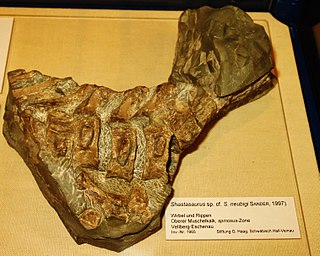
Phantomosaurus is an extinct genus of ichthyosaur that lived during the late Anisian stage of the Middle Triassic. Fossils have been found in southern Germany. It was discovered in 1965 and named in 1997 as a species of Shastasaurus by Sander in the rocks of the Upper Muschelkalk.

Spinophorosaurus is a genus of sauropod dinosaur that lived in what is now Niger during the Middle Jurassic period. The first two specimens were excavated in the 2000s by German and Spanish teams under difficult conditions. The skeletons were brought to Europe and digitally replicated, making Spinophorosaurus the first sauropod to have its skeleton 3D printed, and were to be returned to Niger in the future. Together, the two specimens represented most of the skeleton of the genus, and one of the most completely known basal sauropods of its time and place. The first skeleton was made the holotype specimen of the new genus and species Spinophorosaurus nigerensis in 2009; the generic name refers to what was initially thought to be spiked osteoderms, and the specific name refers to where it was found. A juvenile sauropod from the same area was later assigned to the genus.

Eusauropoda is a derived clade of sauropod dinosaurs. Eusauropods represent the node-based group that includes all descendant sauropods starting with the basal eusauropods of Shunosaurus, and possibly Barapasaurus, and Amygdalodon, but excluding Vulcanodon and Rhoetosaurus. The Eusauropoda was coined in 1995 by Paul Upchurch to create a monophyletic new taxonomic group that would include all sauropods, except for the vulcanodontids.
Qijianglong is a genus of herbivorous mamenchisaurid sauropod dinosaur from the Early Cretaceous of China.

Lingwulong is a genus of dicraeosaurid sauropod dinosaur from the Middle Jurassic of what is now Lingwu, Yinchuan, Ningxia, China. The type and only species is L. shenqi, known from several partial skeletons. It is the earliest-aged neosauropod ever discovered, as well as the only definite diplodocoid from east Asia.

Asfaltovenator is a genus of possibly allosauroid dinosaur from the Lower Jurassic Cañadón Asfalto Formation from Chubut Province, Argentina. The type and only species is Asfaltovenator vialidadi.

Irisosaurus is an extinct genus of sauropodiform sauropodomorph dinosaur, from the Fengjiahe Formation of China. The type species, Irisosaurus yimenensis was formally described in 2020. It was the sister taxon to Mussaurus.

Bashanosaurus is an extinct genus of stegosaurian dinosaur from the Middle Jurassic Shaximiao Formation of Yunyang County, China. The genus contains a single species, Bashanosaurus primitivus, known from incomplete skeletons belonging to three individuals. It is one of the basalmost stegosaurs, as well as one of the oldest known stegosaurs, along with Adratiklit, Isaberrysaura, and Thyreosaurus.
